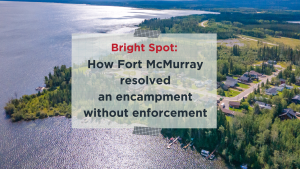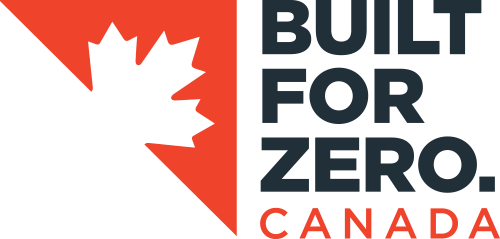A partnership between a local government and public agencies in Fort McMurray has found permanent housing for people experiencing homelessness through a collaborative approach.
In August, the Regional Municipality of Wood Buffalo (RMWB), and partnering community organizations — including Alberta Health Services and the RCMP — peacefully transitioned 29 people from a downtown encampment into housing and other long-term accommodations.
The visible encampment became a matter of public concern and safety. Complaints were made frequently in July by downtown businesses, residents and groups working with the occupants. The RMWB and partnering organizations relocated people to safe environments, ensuring they had access to support services through housing options and appropriate programs to meet their needs.
 Rather than turning to enforcement, RMWB and its partner organizations (The Centre of Hope, The Salvation Army, The YMCA of Northern Alberta, and Wood Buffalo Wellness Society) worked with residents in the encampment throughout the entire relocation process. Their approach was focused on providing housing, services and supports.
Rather than turning to enforcement, RMWB and its partner organizations (The Centre of Hope, The Salvation Army, The YMCA of Northern Alberta, and Wood Buffalo Wellness Society) worked with residents in the encampment throughout the entire relocation process. Their approach was focused on providing housing, services and supports.
The approach in Fort McMurray, built on the back of a strong Coordinated Access System and By-Name List, can serve as a template for other communities across Canada looking to resolve encampments and move people into appropriate housing.
Finding housing, fast
Partnering organizations met almost daily with the RMWB to coordinate planning and ensure all known factors were considered. Collectively, the collaboration and support provided not only to the individuals but to one another as service providers was critical to the success of this effort. From the time the community came together to act, including the day of the move, it was only a two-week period. Before the residents were relocated, RMWB secured a service contract with Wood Buffalo Wellness Society to provide temporary housing with 24/7 support, in collaboration with other housing programs. Once the appropriate housing options were in place, a date was decided by all partners.
Those measures acted as a bridge for residents who later moved into appropriate programs, including treatment, Housing First, and an Indigenous-led supportive housing program, Tawâw, that opened in the winter. Options for housing were communicated to occupants in the encampment in advance, with daily reminders that the site would be closed on August 9 to prepare them for the transition
Ultimately, 18 encampment residents entered the bridge housing program. Six entered Housing First, two were housed in permanent supportive housing, and one person was given a bus ticket to re-connect with family in their home community. Two additional people were peacefully detained due to outstanding warrants and later connected with a case worker to access housing based on their individual needs.
Minimizing anxiety and lessons learned
Packing and preparing to move are common worries for anyone moving into a new home.
With that in mind, on the date of the move, there were more than 45 people — RMWB staff, Elders, non-profit leaders and support staff — ensuring a safe transition for residents as they relocated from the encampment to housing. Indigenous Elders led prayers and smudging ceremonies on-site. As well, Alberta Health Service staff were on call during the move to provide services upon arrival to their accommodations. Contractors were hired to clean up the site after residents were moved.
Bylaw officers and the RCMP blocked off roadways to reduce stress for residents who were completing the move. They worked collaboratively to prevent nearby residents entering the area out of curiosity, to respect the occupants’ privacy. Victim Services was on site to provide Critical Incident Stress Management for individuals who required additional emotional support during the transition.
The move was a resounding success. In the future, the RMWB team said the process may have been made faster if staff were at the site one day earlier to help residents sort through belongings. Consistent communication with local media during and before the move also helped manage the risk of misinformation spreading online.
Impacts on the local community
Since the housing of the 29 encampment residents, the community has continued to collaborate on an enhanced encampment response strategy that is proactive. An encampment outreach staff meets people where they are at and connects with other services providers to enhance response time. As a result, there has been a significant reduction in the average size of encampments in the area and individuals are connected with an agency quickly.
Initially, the trust built with agencies resulting from this response led to an increase in the number of people on the By-Name List, as individuals previously refusing services were eager to receive support. This has allowed the community to accurately capture the number of individuals experiencing chronic homeless and prioritize effectively to ensure they are housed as readily as possible.
Former encampment residents reflected to bridge housing staff that, while the move was challenging, they felt grateful to have more suitable housing. Residents had created their own community in the encampment and continued to look after one another even after they had moved on from the encampment.
Bright Spot: How Fort McMurray resolved an encampment without enforcement
NEXT
